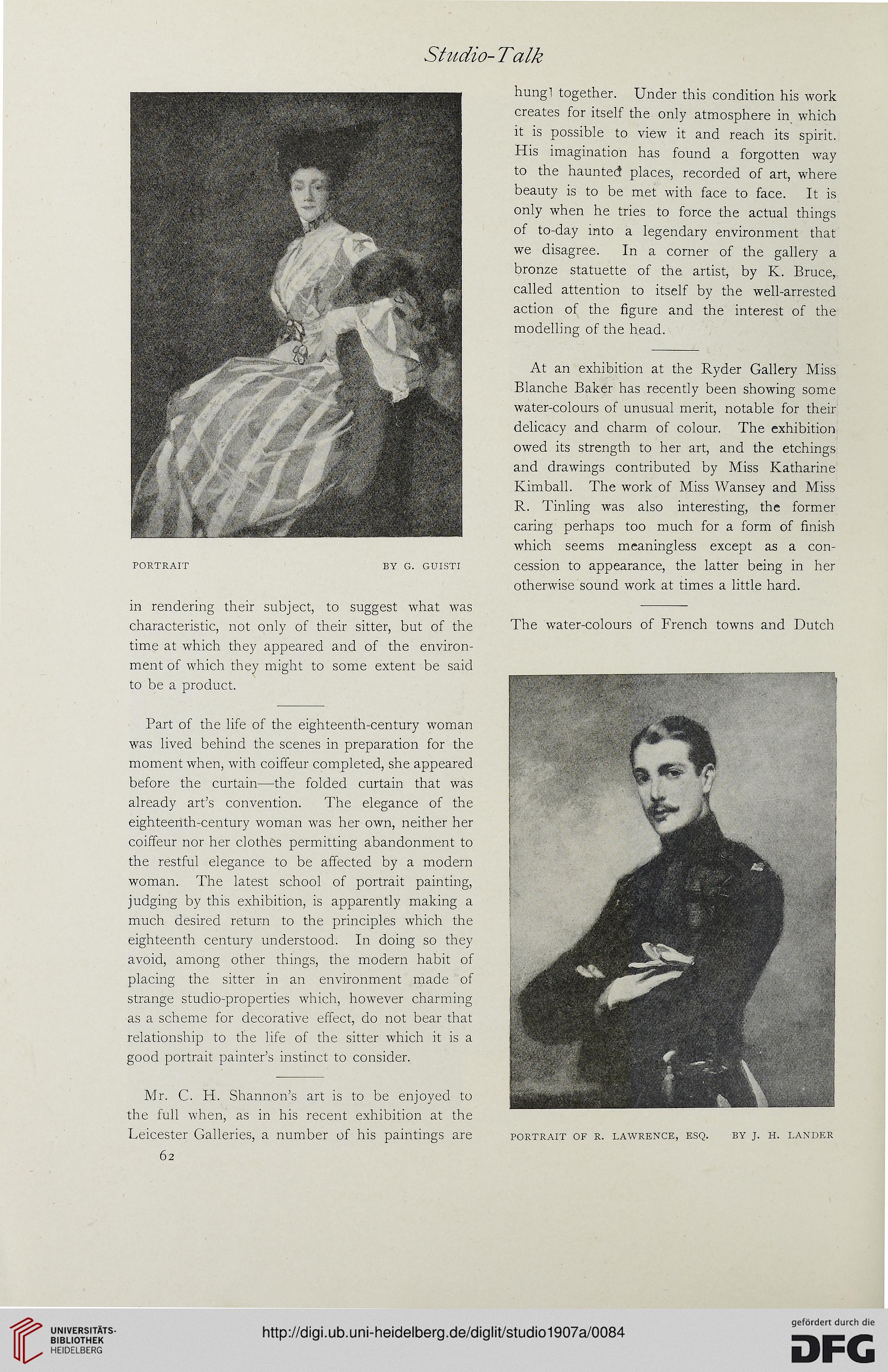Studio-Talk
PORTRAIT BY G. GUISTI
in rendering their subject, to suggest what was
characteristic, not only of their sitter, but of the
time at which they appeared and of the environ-
ment of which they might to some extent be said
to be a product.
Part of the life of the eighteenth-century woman
was lived behind the scenes in preparation for the
moment when, with coiffeur completed, she appeared
before the curtain—the folded curtain that was
already art’s convention. The elegance of the
eighteenth-century woman was her own, neither her
coiffeur nor her clothes permitting abandonment to
the restful elegance to be affected by a modern
woman. The latest school of portrait painting,
judging by this exhibition, is apparently making a
much desired return to the principles which the
eighteenth century understood. In doing so they
avoid, among other things, the modern habit of
placing the sitter in an environment made of
strange studio-properties which, however charming
as a scheme for decorative effect, do not bear that
relationship to the life of the sitter which it is a
good portrait painter’s instinct to consider.
Mr. C. H. Shannon’s art is to be enjoyed to
the full when, as in his recent exhibition at the
Leicester Galleries, a number of his paintings are
62
hung! together. Under this condition his work
creates for itself the only atmosphere in which
it is possible to view it and reach its spirit.
His imagination has found a forgotten way
to the haunted places, recorded of art, where
beauty is to be met with face to face. It is
only when he tries to force the actual things
of to-day into a legendary environment that
we disagree. In a corner of the gallery a
bronze statuette of the artist, by K. Bruce,
called attention to itself by the well-arrested
action of the figure and the interest of the
modelling of the head.
At an exhibition at the Ryder Gallery Miss
Blanche Baker has recently been showing some
water-colours of unusual merit, notable for their
delicacy and charm of colour. The exhibition
owed its strength to her art, and the etchings
and drawings contributed by Miss Katharine
Kimball. The work of Miss Wansey and Miss
R. Tinling was also interesting, the former
caring perhaps too much for a form of finish
which seems meaningless except as a con-
cession to appearance, the latter being in her
otherwise sound work at times a little hard.
The water-colours of French towns and Dutch
PORTRAIT OF R. LAWRENCE, ESQ.
BY J. H. LANDER
PORTRAIT BY G. GUISTI
in rendering their subject, to suggest what was
characteristic, not only of their sitter, but of the
time at which they appeared and of the environ-
ment of which they might to some extent be said
to be a product.
Part of the life of the eighteenth-century woman
was lived behind the scenes in preparation for the
moment when, with coiffeur completed, she appeared
before the curtain—the folded curtain that was
already art’s convention. The elegance of the
eighteenth-century woman was her own, neither her
coiffeur nor her clothes permitting abandonment to
the restful elegance to be affected by a modern
woman. The latest school of portrait painting,
judging by this exhibition, is apparently making a
much desired return to the principles which the
eighteenth century understood. In doing so they
avoid, among other things, the modern habit of
placing the sitter in an environment made of
strange studio-properties which, however charming
as a scheme for decorative effect, do not bear that
relationship to the life of the sitter which it is a
good portrait painter’s instinct to consider.
Mr. C. H. Shannon’s art is to be enjoyed to
the full when, as in his recent exhibition at the
Leicester Galleries, a number of his paintings are
62
hung! together. Under this condition his work
creates for itself the only atmosphere in which
it is possible to view it and reach its spirit.
His imagination has found a forgotten way
to the haunted places, recorded of art, where
beauty is to be met with face to face. It is
only when he tries to force the actual things
of to-day into a legendary environment that
we disagree. In a corner of the gallery a
bronze statuette of the artist, by K. Bruce,
called attention to itself by the well-arrested
action of the figure and the interest of the
modelling of the head.
At an exhibition at the Ryder Gallery Miss
Blanche Baker has recently been showing some
water-colours of unusual merit, notable for their
delicacy and charm of colour. The exhibition
owed its strength to her art, and the etchings
and drawings contributed by Miss Katharine
Kimball. The work of Miss Wansey and Miss
R. Tinling was also interesting, the former
caring perhaps too much for a form of finish
which seems meaningless except as a con-
cession to appearance, the latter being in her
otherwise sound work at times a little hard.
The water-colours of French towns and Dutch
PORTRAIT OF R. LAWRENCE, ESQ.
BY J. H. LANDER




